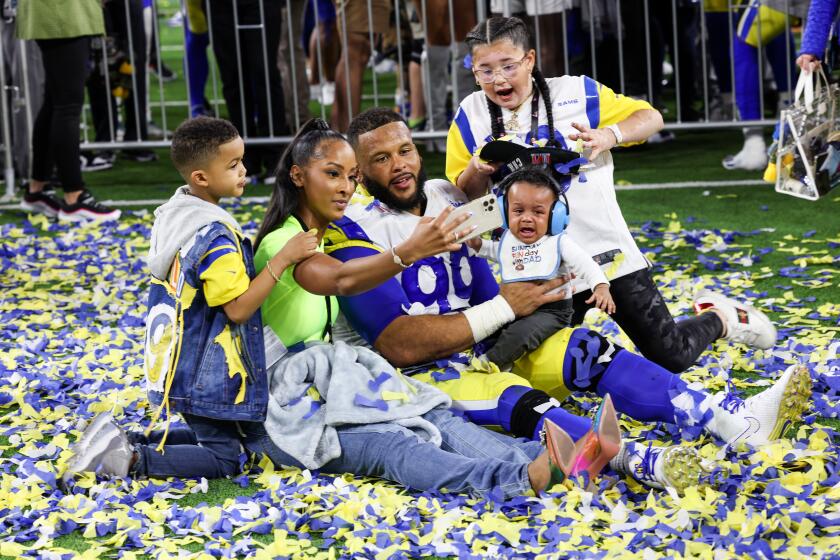A Reluctant Farewell to a Latino Role Model
The sun was shining in the barrios of San Fernando Thursday, but for Raymond Rivera, a 15-year-old pitcher for the San Fernando High School Tigers, spring had suddenly died.
Fernando Valenzuela--Raymond’s childhood hero, the powerhouse whose windmill windup is depicted on the posters covering Raymond’s bedroom walls, the Mexican-born superstar whom Raymond’s uncles called “ El Toro “ and cheered during family pilgrimages to Dodger Stadium--had just been cut by the Los Angeles Dodgers.
Rivera reacted to the news as he stood in the cafeteria among boisterous teammates heading for a baseball game that afternoon. His voice was hard to hear. He looked down.
“I don’t think they should have let him go,” said Rivera, a lean youth with close-cropped hair. “He still has two or three more years. He wasn’t a hotdog. He didn’t mouth off. He did his job.”
In the 1980s, Valenzuela was the sports hero in the city of San Fernando and other working-class, predominantly Latino communities. At the zenith of Fernandomania in 1985, Valenzuela visited San Fernando High and other schools in the area to urge kids to stay in school, speaking mostly Spanish and accompa-nied by an interpreter. The reception he received was an apotheosis, Coach Steve Marden said.
“Here was a Latino making it big time,” Marden said. “He had a profound impact. He will go down in history as the guy who brought baseball to this place, as the guy who let these kids know they could get it done.”
Juan De Paz, a 17-year-old team manager who was born in El Salvador and has a Fernando-esque build, said: “For me, he’s a good pitcher, one of the best there is. Hispanics, when they saw him pitch, it was a big deal. You feel proud or something.”
Valenzuela had struggled recently. Some of Rivera’s teammates shrugged off his release, saying he had been eclipsed by more recent baseball heroes such as Oakland’s Jose Canseco.
“I’m glad they got rid of him,” assistant coach Abel Ramirez said. “He was useless.”
But in interviews on the streets of San Fernando Thursday, young, middle-aged and old men alike stopped and reflected on the passing of a mythic figure and role model. They relived the no-hitter and his home runs. They tried to put into words the emotions that Valenzuela leaves behind.
“The people would come all the way from Tijuana, from Mexicali by bus, to see him play,” 72-year-old Manuel Villalobos said in Spanish. Villalobos, a retired asphalt laborer, occupied his usual perch on a concrete planter on the San Fernando Mall, a spot from which he said he and other retired men have spent long hours over the years discussing Valenzuela’s exploits.
“It was great to see him pitch,” he said. “And he could hit. . . . “
Villalobos waved a sun-darkened hand, made a spitting sound and used an unprintable adjective about the Dodger organization’s decision to let Valenzuela go.
Next to him, bespectacled Jose Gonzalez, 70, rocked back and forth with his hands clasped behind his back. He predicted that Valenzuela will make a comeback as a relief pitcher. And he complained, to the accompaniment of nods and murmured assent, that the Dodgers had speeded Valenzuela’s troubles by using him too frequently.
“They didn’t let him rest,” he said. “He pitched too much.”
Several blocks away, street vendor Raul Montesinos had a similar opinion.
Montesinos is not a big baseball fan, but he said he has followed Valenzuela’s career avidly. And as he stood behind a pushcart labeled “ Delicias De Michoacan ,” the top of the cart covered with soda pop cans, candy bars and small change, the 37-year-old vendor expressed sympathy for his 30-year-old millionaire countryman.
“He gave them everything he had,” he said. “It’s like a worker when he’s all used up and the boss gets rid of him because he’s of no use anymore.”
More to Read
Go beyond the scoreboard
Get the latest on L.A.'s teams in the daily Sports Report newsletter.
You may occasionally receive promotional content from the Los Angeles Times.










